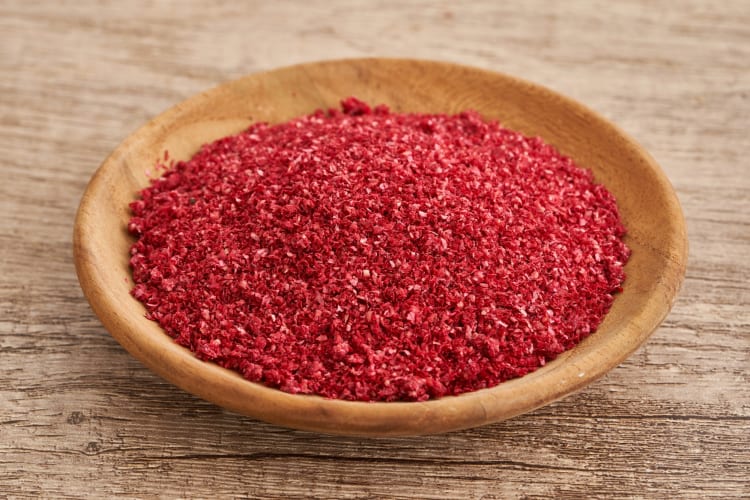Are you cooking and realize you’re out of sumac? Don’t worry.
There’s always a solution in the kitchen. Sumac, a tangy spice from the Middle East, adds a unique flavor to dishes. But, it’s not always available in every pantry. Sumac’s bright, lemony taste brings a special zest to meals. It’s often sprinkled over salads, meats, and rice.
If you find yourself without sumac, there are several substitutes that can mimic its tartness. These alternatives can help you achieve a similar flavor profile in your recipe. Ready to discover some easy-to-find sumac substitutes? Let’s dive in and explore your options.

Credit: www.rachaelrayshow.com
Lemon Zest
Lemon zest is a great substitute for sumac in recipes. It offers a bright, tangy flavor. This makes it a versatile ingredient in various dishes. Lemon zest is the outer yellow skin of a lemon. It is rich in essential oils, adding a burst of citrusy aroma. This can elevate the taste of your meals significantly.
Flavor Profile
Lemon zest has a vibrant and refreshing taste. It is tangy, with a slight bitterness. This makes it a good match for sumac’s tart flavor. The zest also has a fragrant citrus aroma. This can enhance the overall flavor of your dish. It pairs well with many herbs and spices.
How To Use In Recipes
Using lemon zest in recipes is easy. You can grate the zest directly onto your dish. This works well for salads, dressings, and marinades. It can also be mixed into sauces and dips. For baked goods, add the zest to the batter or dough. This gives a subtle, citrusy note.
For savory dishes, sprinkle lemon zest over roasted vegetables. It adds a fresh, tangy touch. You can also mix it into rice or couscous. This makes the grains more flavorful. In soups and stews, lemon zest adds brightness. It balances the richness of the dish.
Remember to use only the yellow part of the skin. The white pith underneath is bitter. A microplane grater is ideal for zesting. It produces fine, delicate strands. These blend well into your recipes.
Tamarind Paste
If you need a substitute for sumac in your recipes, consider using Tamarind Paste. This tangy and versatile ingredient can mimic the unique flavor of sumac. Tamarind paste is easy to find and adds a zesty twist to many dishes.
Flavor Profile
Tamarind paste offers a tangy and sweet flavor with a hint of sourness. This distinct taste can closely replicate the citrusy and tart profile of sumac. It adds depth and complexity to your dishes, making it an excellent alternative.
The paste is made from the pulp of tamarind fruit. Its flavor is more intense than sumac, so use it sparingly. When diluted, tamarind paste can provide the desired tartness and zest without overpowering the dish.
How To Use In Recipes
Using tamarind paste as a sumac substitute is simple. Here are some tips:
- Marinades: Mix tamarind paste with olive oil, garlic, and herbs for a tangy marinade.
- Dressings: Add a teaspoon to salad dressings for a citrusy kick.
- Dips: Blend with yogurt, spices, and salt for a zesty dip.
Below is a quick conversion table for using tamarind paste:
| Sumac | Tamarind Paste |
|---|---|
| 1 tsp | 1/2 tsp (diluted) |
| 1 tbsp | 1 tsp (diluted) |
Always start with a small amount and adjust to taste. Tamarind paste can be strong, so a little goes a long way.
Vinegar
If you need a substitute for sumac in a recipe, vinegar can be a great alternative. Vinegar offers a tangy and acidic flavor that can mimic the tartness of sumac. It is easily available and can be found in most kitchens. Let’s explore how vinegar can be used as a substitute for sumac.
Flavor Profile
Vinegar has a sharp, tangy taste. This acidity can replicate the sour notes of sumac. There are different types of vinegar, each with its own flavor. For instance:
- Apple cider vinegar: Slightly sweet and fruity.
- White vinegar: Pure and strong acidity.
- Red wine vinegar: Rich and robust flavor.
Each type brings a unique taste. Choose the one that best matches your recipe.
How To Use In Recipes
Using vinegar to replace sumac is simple. Here are some tips:
- Start with a small amount. About 1 teaspoon of vinegar can replace 1 teaspoon of sumac.
- Taste and adjust as needed. Vinegar is potent, so add gradually.
- Mix it with herbs. Combine vinegar with dried herbs like thyme or oregano.
Vinegar works well in salads, marinades, and sauces. Here is an example:
Salad Dressing:
- 2 tablespoons olive oil
- 1 tablespoon apple cider vinegar
- 1 teaspoon dried oregano
- Salt and pepper to taste
Whisk ingredients together and drizzle over your salad. This simple mix gives a tangy and fresh flavor, similar to sumac.

Credit: www.cozymeal.com
Pomegranate Molasses
Pomegranate molasses is an excellent substitute for sumac in recipes. This thick, tangy syrup is made from reduced pomegranate juice. It offers a unique flavor that can enhance various dishes. Let’s explore its flavor profile and how to use it in recipes.
Flavor Profile
Pomegranate molasses has a complex flavor. It combines sweet and sour notes. The syrup is intensely tangy with a hint of sweetness. Its deep, fruity taste can mimic sumac’s tartness. This makes it a suitable alternative in many recipes.
How To Use In Recipes
Use pomegranate molasses in marinades. Mix it with olive oil, garlic, and herbs. This blend is perfect for chicken, lamb, or beef. It adds a rich, tangy flavor to grilled meats.
Drizzle pomegranate molasses over roasted vegetables. It enhances their natural sweetness. Try it on carrots, beets, or sweet potatoes. The syrup’s acidity balances their flavors.
Add it to salad dressings. Combine it with olive oil and lemon juice. This dressing pairs well with mixed greens, nuts, and cheese. It brings a vibrant taste to your salads.
Pomegranate molasses can also be used in dips. Stir it into hummus or baba ganoush. It adds a unique, tangy twist. Serve these dips with fresh vegetables or pita bread.
Experiment with pomegranate molasses in your recipes. Its versatility and distinct flavor make it a great sumac substitute.
Lemon Juice
Sumac is a popular spice in Middle Eastern cuisine, known for its tangy flavor. If you don’t have sumac, lemon juice can be an excellent substitute. Lemon juice brings a similar tartness and brightness to dishes, making it a versatile replacement.
Flavor Profile
Lemon juice offers a fresh, citrusy flavor with a hint of sweetness. Its acidity can enhance the taste of many dishes, adding a vibrant, zesty note. Like sumac, it provides a sharp, tangy taste that can brighten up any recipe.
How To Use In Recipes
Using lemon juice as a substitute for sumac is simple. Here are some ways to incorporate it into your cooking:
- Salads: Drizzle lemon juice over salads for a fresh, tangy flavor.
- Marinades: Use lemon juice in marinades for meat or vegetables. It tenderizes and adds zest.
- Dressings: Combine lemon juice with olive oil, garlic, and herbs for a delicious dressing.
- Seasoning: Sprinkle lemon juice over grilled fish or chicken for a burst of flavor.
| Recipe | How to Use Lemon Juice |
|---|---|
| Hummus | Add 1-2 tablespoons of lemon juice for a tangy twist. |
| Tabbouleh | Mix lemon juice with parsley, tomatoes, and bulgur for extra zing. |
| Grilled Vegetables | Drizzle lemon juice before serving for added brightness. |
Remember, lemon juice is more potent than sumac, so start with a small amount and adjust to taste. Its versatility makes it an essential ingredient in your kitchen.
Citric Acid
Finding a substitute for sumac in recipes can be challenging. One excellent option is citric acid. Citric acid is a natural compound found in citrus fruits. It is known for its tangy and sour flavor. This makes it a great alternative to sumac.
Flavor Profile
Citric acid has a sharp, tangy taste. It mimics the tartness of sumac well. This makes it a suitable replacement in many dishes. Its sour notes add brightness to recipes. It enhances the overall flavor without overpowering other ingredients.
How To Use In Recipes
To use citric acid in recipes, start with a small amount. Usually, a pinch or two is enough. Sprinkle it over salads or mix it into dressings. You can also add it to marinades and rubs. This will give your dishes that desired tangy kick. Adjust the amount based on your taste preference. Citric acid is potent, so a little goes a long way.
Za’atar
Za’atar is a flavorful spice blend commonly used in Middle Eastern cuisine. It has a complex taste that can elevate many dishes. If you need a substitute for sumac in a recipe, za’atar can be a great option.
Flavor Profile
Za’atar typically contains a mix of dried thyme, sesame seeds, sumac, and salt. The blend provides a herbaceous and slightly nutty flavor. Its sumac component adds a touch of tanginess. This makes za’atar a well-rounded and versatile spice.
How To Use In Recipes
Using za’atar in recipes is simple and effective. Here are some ideas:
- Sprinkle on salads: Add za’atar to salads for extra flavor.
- Season meats: Rub za’atar on chicken, beef, or lamb before cooking.
- Mix with olive oil: Combine za’atar with olive oil as a dip for bread.
- Add to roasted vegetables: Toss vegetables with za’atar before roasting.
Za’atar can also be used in marinades or sprinkled over hummus. Its diverse flavor makes it an excellent substitute for sumac.

Credit: www.thespicehouse.com
Frequently Asked Questions
What Can I Use Instead Of Sumac?
You can use lemon zest, vinegar, or tamarind as substitutes for sumac. These ingredients provide a similar tangy flavor.
Is Lemon Juice A Good Sumac Substitute?
Yes, lemon juice can be a good substitute for sumac. It offers a similar tart and tangy taste.
Can I Replace Sumac With Vinegar?
Yes, vinegar can replace sumac in recipes. Choose apple cider or red wine vinegar for the best results.
What Spice Is Similar To Sumac?
Tamarind is a spice similar to sumac. It provides a sour and tangy flavor, much like sumac.
Conclusion
Finding a substitute for sumac in recipes is easy. Options like lemon zest, vinegar, or tamarind work well. They add the needed tangy flavor. Experiment with these alternatives. Each gives a unique twist to your dish. You won’t miss sumac with these substitutes.
Cooking is about creativity. Enjoy trying new flavors. Happy cooking!
